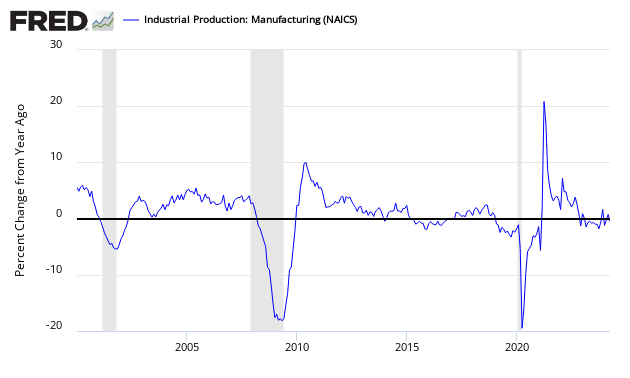July 2018 Empire State Manufacturing Index Declined
The Empire State Manufacturing Survey index declined but remains in expansion. The key internals declined.

Analyst Opinion of Empire State Manufacturing Survey
I am not a fan of surveys - and this survey jumps around erratically - but has been relatively steady for the last year. Key internals in the report declined. This report was weaker than last month.
- Expectations from Nasdaq / Econoday were for a reading between 17.0 to 26.0 (consensus 21.0) versus the 22.6 reported. Any value above zero shows expansion for the New York area manufacturers.
- New orders sub-index of the Empire State Manufacturing improved and remains in expansion, whilst the unfilled orders sub-index improved and remains in expansion...
- This noisy index has moved from 9.8 (July 2017), 25.2 (August), 24.4 (September), 30.2 (October), 19.4 (November), 18.0 (December), 17.7 (January 2018), 13.1 (February), 22.5 (March), 15.8 (April), 20.1 (May), 25.0 (June) - and now 22.6.
As this index is very noisy, it is hard to understand what these massive moves up or down mean.
Econintersect reminds you that this is a survey (a quantification of opinion). Please see caveats at the end of this post. However, sometimes it is better not to look too deeply into the details of a noisy survey as just the overview is all you need to know.
From the report:
Business activity continued to grow at a fairly brisk pace in New York State, according to firms responding to the July 2018 Empire State Manufacturing Survey. The headline general business conditions index edged down by over two points to 22.6—still a high level, suggesting a continuation of robust growth. The new orders index dipped three points to 18.2, while the shipments index fell nine points to 14.6, pointing to a modest pullback in growth of orders and shipments. Delivery times continued to rise, and inventories fell marginally. Labor market indicators pointed to continued sturdy growth in employment and a modest increase in the workweek. The prices paid index slipped ten points to 42.7—still a fairly high level indicative of widespread ongoing input price pressures; the prices received index was little changed at 22.2, signaling continued moderate increases in selling prices. Looking ahead, firms were slightly less optimistic about the six-month outlook than they were last month.
(Click on image to enlarge)
The above graphic shows that when the index is in negative territory that it is not a signal of a recession - of 10 times in negative territory (since the Great Recession) - no recession occurred. Conversely, a positive number is likely to be indicating economic expansion. Historically, when it does make a correct negative prediction it can be timely - this index was only two months late in going negative after what was eventually determined to be the start of the 2007 recession.
This survey has a lot of extra bells and whistles which take attention away from the core questions: (1) are orders and (2) are unfilled orders (backlog) improving? - and the answer is no for this month.
(Click on image to enlarge)
Unfilled order contraction can be a signal for a recession.
Summary of all Federal Reserve Districts Manufacturing:
Richmond Fed (hyperlink to reports):
(Click on image to enlarge)
Kansas Fed (hyperlink to reports):
(Click on image to enlarge)
Dallas Fed (hyperlink to reports):
(Click on image to enlarge)
Philly Fed (hyperlink to reports):
(Click on image to enlarge)
New York Fed (hyperlink to reports):
(Click on image to enlarge)
Federal Reserve Industrial Production - Actual Data (hyperlink to report):
(Click on image to enlarge)

Holding this and other survey's Econintersect follows accountable for their predictions, the following graph compares the hard data from Industrial Products manufacturing subindex (dark blue bar) and US Census manufacturing shipments (lighter blue bar) to the Dallas Fed survey (light blue bar).
(Click on image to enlarge)

In the above graphic, hard data is the long bars, and surveys are the short bars. The arrows on the left side are the key to growth or contraction.
Caveats on the use of Empire State Manufacturing Survey:
This is a survey, a quantification of opinion - not facts and data. Surveys lead hard data by weeks to months, and can provide early insight into changing conditions. Econintersect finds they do not necessarily end up being consistent compared to hard economic data that comes later, and can miss economic turning points.
According to Nasdaq / Econoday:
The New York Fed conducts this monthly survey of manufacturers in New York State. Participants from across the state represent a variety of industries. On the first of each month, the same pool of roughly 175 manufacturing executives (usually the CEO or the president) is sent a questionnaire to report the change in an assortment of indicators from the previous month. Respondents also give their views about the likely direction of these same indicators six months ahead.
This Empire State Survey is very noisy - and has shown recessionary conditions throughout the second half of 2011 - and no recession resulted. Overall, since the end of the 2007 recession - this index has indicated two false recession warnings.
No survey is accurate in projecting employment - and the Empire State Manufacturing Survey is no exception. Although there are some general correlation in trends, month-to-month movements have not correlated with the BLS Service Sector Employment data.
Over time, there is a general correlation with real manufacturing data - but month-to-month conflicts are frequent.
Disclosure: None.










